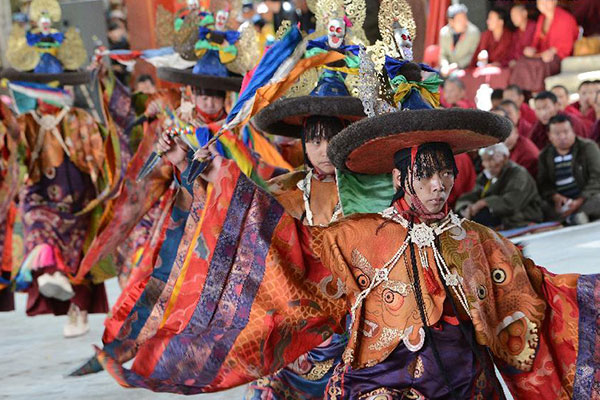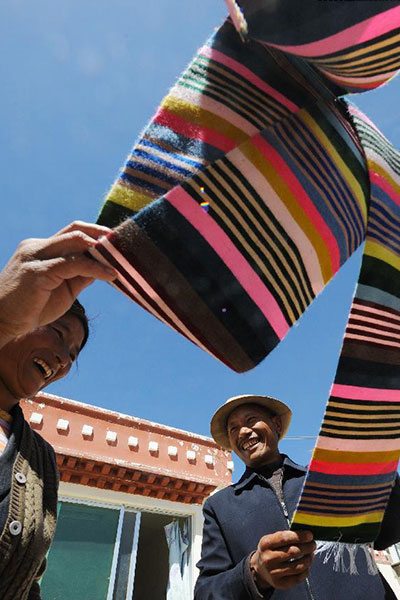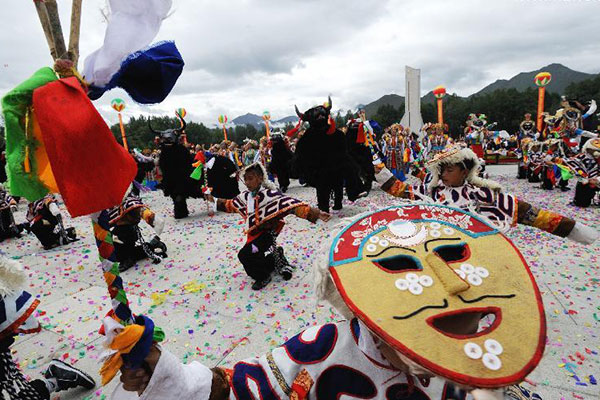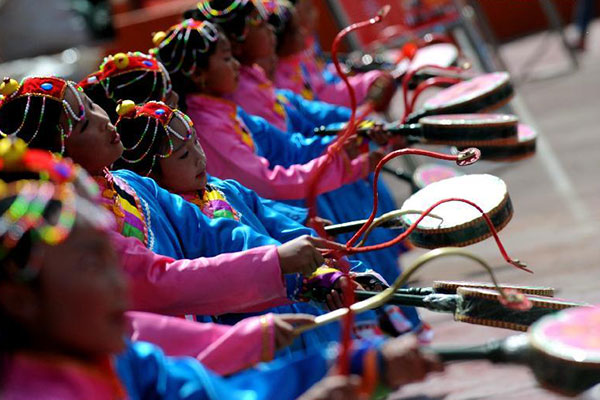
This photo taken on Sept 26, 2014, shows monks performing “Qiangmu”, a religious dance of the Tibetan ethnic group, at the Tashilumpo Monastery in Southwest China’s Tibet autonomous region. Since 2005, China has allocated about 130 million yuan (about $20 million) for the protection of intangible cultural heritage (ICH) in Tibet, preserving about 800 local cultural practices and expressions of intangible heritage, and opening 30 inheritance bases.[Photo/Xinhua]

This photo taken on March 16, 2012 shows farmers performing “Guozhuang”, a dance of the Tibetan ethnic group, during a spring plowing ceremony in Doilungdeqen county of Southwest China’s Tibet autonomous region. Since 2005, China has allocated about 130 million yuan (about $20 million) for the protection of intangible cultural heritage (ICH) in Tibet, preserving about 800 local cultural practices and expressions of intangible heritage, and opening 30 inheritance bases.[Photo/Xinhua]

This photo taken on Sept 11, 2010 shows a Tibetan child flying a kite in Lhasa of Southwest China’s Tibet autonomous region. Since 2005, China has allocated about 130 million yuan (about $20 million) for the protection of intangible cultural heritage (ICH) in Tibet, preserving about 800 local cultural practices and expressions of intangible heritage, and opening 30 inheritance bases.[Photo/Xinhua]

This photo taken on Sept 12, 2006 shows a doctor preparing medicine for a patient at a hospital in Southwest China’s Tibet autonomous region. Since 2005, China has allocated about 130 million yuan (about $20 million) for the protection of intangible cultural heritage (ICH) in Tibet, preserving about 800 local cultural practices and expressions of intangible heritage, and opening 30 inheritance bases.[Photo/Xinhua]

This photo taken on March 17, 2010 shows a couple drying a traditional type of apron, called “Bangdian,” in Jedexoi Town of Southwest China’s Tibet autonomous region. Since 2005, China has allocated about 130 million yuan (about $20 million) for the protection of intangible cultural heritage (ICH) in Tibet, preserving about 800 local cultural practices and expressions of intangible heritage, and opening 30 inheritance bases. [Photo/Xinhua]

This photo taken on Aug 20, 2009 shows pupils performing a traditional style of opera at the Potala Palace in Lhasa city of Southwest China’s Tibet autonomous region. Since 2005, China has allocated about 130 million yuan (about $20 million) for the protection of intangible cultural heritage (ICH) in Tibet, preserving about 800 local cultural practices and expressions of intangible heritage, and opening 30 inheritance bases.[Photo/Xinhua]

This photo taken on Aug 17, 2012 shows local residents taking part in an activity during the Shoton (Yogurt) Festival at the Zhaibung Monastery in Lhasa city of Southwest China’s Tibet autonomous region. Since 2005, China has allocated about 130 million yuan (about $20 million) for the protection of intangible cultural heritage (ICH) in Tibet, preserving about 800 local cultural practices and expressions of intangible heritage, and opening 30 inheritance bases.[Photo/Xinhua]

This photo taken on June 22, 2011 shows a local resident making paper in Nyemo of Southwest China’s Tibet autonomous region. Since 2005, China has allocated about 130 million yuan (about $20 million) for the protection of intangible cultural heritage (ICH) in Tibet, preserving about 800 local cultural practices and expressions of intangible heritage, and opening 30 inheritance bases.[Photo/Xinhua]

This photo taken on June 1, 2011 shows pupils performing the traditional “Reba” dance during a celebration for International Children’s Day, in Lhasa City of Southwest China’s Tibet autonomous region. Since 2005, China has allocated about 130 million yuan (about $20 million) for the protection of intangible cultural heritage (ICH) in Tibet, preserving about 800 local cultural practices and expressions of intangible heritage, and opening 30 inheritance bases.[Photo/Xinhua]

This file photo shows ranchers taking part in a storytelling activity in Southwest China’s Tibet autonomous region. Since 2005, China has allocated about 130 million yuan (about $20 million) for the protection of intangible cultural heritage (ICH) in Tibet, preserving about 800 local cultural practices and expressions of intangible heritage, and opening 30 inheritance bases.[Photo/Xinhua]
